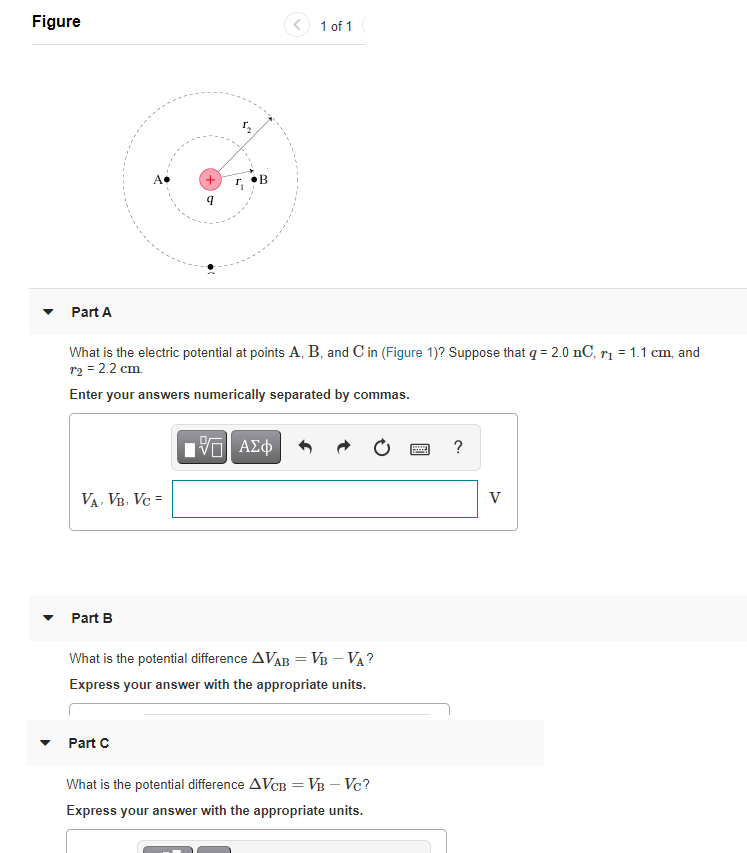, •B Part A What is the electric potential at points A, B, and C in (Figure 1)? Suppose that q = 2.0 nC, r1 = 1.1 cm, and r2 = 2.2 cm Enter your answers numerically separated by commas. ν ΑΣφ ? VA, VB. Vc = V Part B What is the potential difference AVAB = VB – VA? Express your answer with the appropriate units. Part C What is the potential difference AVCB = VB – Vc? Express your answer with the appropriate units.
, •B Part A What is the electric potential at points A, B, and C in (Figure 1)? Suppose that q = 2.0 nC, r1 = 1.1 cm, and r2 = 2.2 cm Enter your answers numerically separated by commas. ν ΑΣφ ? VA, VB. Vc = V Part B What is the potential difference AVAB = VB – VA? Express your answer with the appropriate units. Part C What is the potential difference AVCB = VB – Vc? Express your answer with the appropriate units.
Physics for Scientists and Engineers, Technology Update (No access codes included)
9th Edition
ISBN:9781305116399
Author:Raymond A. Serway, John W. Jewett
Publisher:Raymond A. Serway, John W. Jewett
Chapter25: Electric Potential
Section: Chapter Questions
Problem 25.1OQ: In a certain region of space, the electric field is zero. From this fact, what can you conclude...
Related questions
Question

Transcribed Image Text:Figure
1 of 1
+)
Part A
What is the electric potential at points A, B, and C in (Figure 1)? Suppose that q = 2.0 nC, rị = 1.1 cm, and
r2 = 2.2 cm.
Enter your answers numerically separated by commas.
Hνα ΑΣφ
VA, VB. Vc =
V
Part B
What is the potential difference AVAB =VB – VA ?
Express your answer with the appropriate units.
Part C
What is the potential difference AVCB = VB – Vc?
Express your answer with the appropriate units.
Expert Solution
This question has been solved!
Explore an expertly crafted, step-by-step solution for a thorough understanding of key concepts.
This is a popular solution!
Trending now
This is a popular solution!
Step by step
Solved in 3 steps

Knowledge Booster
Learn more about
Need a deep-dive on the concept behind this application? Look no further. Learn more about this topic, physics and related others by exploring similar questions and additional content below.Recommended textbooks for you

Physics for Scientists and Engineers, Technology …
Physics
ISBN:
9781305116399
Author:
Raymond A. Serway, John W. Jewett
Publisher:
Cengage Learning

Physics for Scientists and Engineers, Technology …
Physics
ISBN:
9781305116399
Author:
Raymond A. Serway, John W. Jewett
Publisher:
Cengage Learning